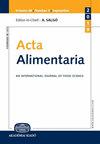匈牙利与冠状病毒疾病(新冠肺炎)相关的口味和食物偏好变化调查
IF 1
4区 农林科学
Q4 FOOD SCIENCE & TECHNOLOGY
引用次数: 0
摘要
大量的研究和经验性观察支持这样一种说法,即在其他症状中,疾病经常影响嗅觉和味觉的能力,可能也会影响味觉和食物偏好。本研究的目的是阐明与COVID-19相关的嗅觉障碍(嗅觉障碍/嗅觉缺失)和味觉功能障碍/丧失(嗅觉障碍/听觉障碍)对不同症状和已有疾病以及人口背景的COVID-19患者食物和味觉偏好的影响。该研究基于描述性、横断面调查。总共有514名参与者填写了我们自我管理的在线问卷。根据排除标准排除13名受试者。进行描述性统计、卡方检验、相关系数t检验。最常见的长时间COVID症状是疲劳/虚弱(53.1%),其次是嗅觉丧失(50.9%)和心动过速(33.5%)。许多参与者报告在疾病的急性阶段出现了语言障碍/年龄障碍,这有时作为长期的COVID症状普遍存在。很高比例的参与者报告说,他们在恢复期间拒绝了除冷切肉以外的所有动物源性肉类,这被证明是迄今为止后covid期间最常见的饮食变化。本文章由计算机程序翻译,如有差异,请以英文原文为准。
A survey of changes in taste and food preferences related to the coronavirus disease (COVID-19) in Hungary
A plethora of research and empiric observation supported the claim that–among other symptoms–diseases often affect the ability to smell and the sense of taste, possibly affecting the taste- and food preferences as well.The aim of the present study was to shed light on the impact of COVID-related smell- (dysosmia/anosmia) and taste function-disorder/loss (dysgeusia/ageusia) on the food and taste preferences COVID-19 patients of different symptomatic and pre-existing conditions and demographic backgrounds.The research based on a descriptive, cross-sectional survey. In total, 514 participants filled our self-administered online questionnaire. Thirteen participants were excluded according to the exclusion criteria. Descriptive statistics, Chi-square test, t-test for correlation coefficient, were performed.The most common long COVID symptom was fatigue/weakness (53.1%) followed by anosmia (50.9%) and tachycardia (33.5%). Many participants reported dysgeusia/ageusia during the acute phase of the disease, which sometimes prevailed as a long COVID symptom. A high percentage of participants reported that they rejected all kinds of meat of animal origin except cold cuts for their duration of recuperation, which proved to be the most common dietary change during the post-COVID period so far.
求助全文
通过发布文献求助,成功后即可免费获取论文全文。
去求助
来源期刊

Acta Alimentaria
农林科学-食品科技
CiteScore
1.80
自引率
0.00%
发文量
47
审稿时长
18-36 weeks
期刊介绍:
Acta Alimentaria publishes original papers and reviews on food science (physics, physical chemistry, chemistry, analysis, biology, microbiology, enzymology, engineering, instrumentation, automation and economics of foods, food production and food technology, food quality, post-harvest treatments, food safety and nutrition).
 求助内容:
求助内容: 应助结果提醒方式:
应助结果提醒方式:


